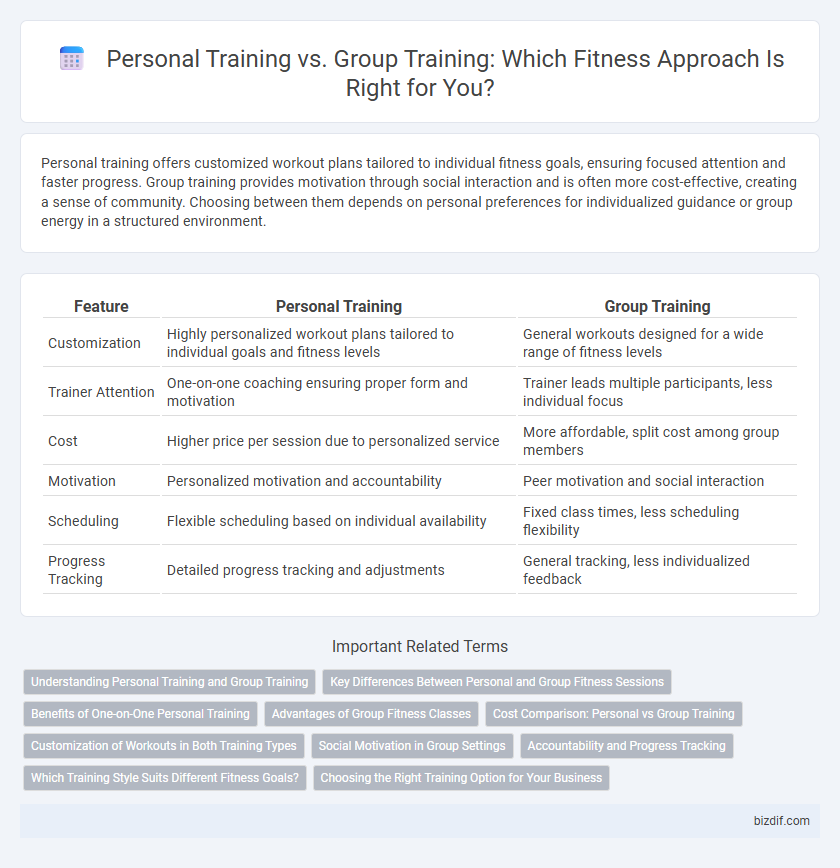Personal training offers customized workout plans tailored to individual fitness goals, ensuring focused attention and faster progress. Group training provides motivation through social interaction and is often more cost-effective, creating a sense of community. Choosing between them depends on personal preferences for individualized guidance or group energy in a structured environment.
Table of Comparison
| Feature | Personal Training | Group Training |
|---|---|---|
| Customization | Highly personalized workout plans tailored to individual goals and fitness levels | General workouts designed for a wide range of fitness levels |
| Trainer Attention | One-on-one coaching ensuring proper form and motivation | Trainer leads multiple participants, less individual focus |
| Cost | Higher price per session due to personalized service | More affordable, split cost among group members |
| Motivation | Personalized motivation and accountability | Peer motivation and social interaction |
| Scheduling | Flexible scheduling based on individual availability | Fixed class times, less scheduling flexibility |
| Progress Tracking | Detailed progress tracking and adjustments | General tracking, less individualized feedback |
Understanding Personal Training and Group Training
Personal training offers individualized workout plans tailored to specific fitness goals, providing one-on-one coaching and personalized attention from certified trainers. Group training emphasizes social motivation and structured sessions in a community setting, often leading to increased accountability and variety in exercises. Both formats enhance physical fitness but cater to different preferences and needs based on personal motivation and training styles.
Key Differences Between Personal and Group Fitness Sessions
Personal training provides tailored workout plans targeting individual fitness goals, allowing for customized guidance and real-time adjustments based on performance data. Group training offers a social environment that enhances motivation and accountability but follows a standardized routine designed for diverse fitness levels. The choice depends on whether personalized attention or communal energy better supports one's fitness journey.
Benefits of One-on-One Personal Training
One-on-one personal training offers tailored workout plans that address individual fitness goals, ensuring efficient progress and reducing the risk of injury. Customized attention from a certified trainer provides motivation, expert guidance, and immediate feedback for optimal form and technique. Personalized training sessions adapt to each client's unique needs, promoting faster improvements in strength, endurance, and overall health compared to group training settings.
Advantages of Group Fitness Classes
Group fitness classes offer an energizing environment that boosts motivation through social interaction and collective encouragement, enhancing workout adherence and enjoyment. Participants benefit from professional guidance at a lower cost than personal training, making structured exercise more accessible for diverse fitness levels. The variety and dynamic pace of group sessions promote improved cardiovascular health, strength, and flexibility while fostering community support and accountability.
Cost Comparison: Personal vs Group Training
Personal training typically incurs higher costs, often ranging from $40 to $100 per session due to one-on-one coaching and customized workout plans. Group training sessions reduce expenses significantly, averaging between $15 to $30 per class by distributing the trainer's time among multiple participants. Budget-conscious fitness enthusiasts may find group training a more affordable option while still receiving professional guidance.
Customization of Workouts in Both Training Types
Personal training offers highly customized workouts tailored to individual fitness levels, goals, and medical conditions, ensuring maximum effectiveness and safety. Group training provides structured routines designed for a broader audience but can incorporate modifications to suit different abilities within the group. Both training types emphasize exercise variety, yet personal training delivers a more precise approach for personalized progress tracking and goal achievement.
Social Motivation in Group Settings
Group training enhances social motivation by fostering a supportive community where participants encourage each other, increasing accountability and consistency. Personal training offers tailored guidance but may lack the dynamic peer interaction that drives motivation in group settings. The energy and camaraderie in group workouts often lead to higher engagement and sustained exercise adherence.
Accountability and Progress Tracking
Personal training provides tailored accountability with one-on-one coaching, enabling precise progress tracking through customized workout plans and regular assessments. Group training fosters social accountability and motivation, but progress tracking often relies on generalized benchmarks rather than individualized metrics. Tracking progress effectively in either setting enhances commitment and helps optimize fitness outcomes.
Which Training Style Suits Different Fitness Goals?
Personal training offers customized workout plans tailored to individual fitness goals such as weight loss, muscle gain, or rehabilitation, ensuring focused progression and minimized injury risk. Group training provides a motivating environment ideal for improving general fitness, cardiovascular health, and social engagement, often supporting consistency and enthusiasm. Choosing between personal and group training depends on specific objectives, with personal training suited for targeted results and group sessions excelling in fostering accountability and community support.
Choosing the Right Training Option for Your Business
Personal training offers customized fitness programs tailored to individual client goals, ensuring personalized attention and faster progress, making it ideal for businesses aiming to deliver premium, client-specific services. Group training maximizes efficiency by accommodating multiple clients simultaneously, fostering community engagement and cost-effectiveness, which suits businesses targeting scalability and a broader customer base. Evaluating your business model, target audience, and resource availability is essential to select the optimal training option that aligns with your strategic growth objectives.
Personal Training vs Group Training Infographic

 bizdif.com
bizdif.com